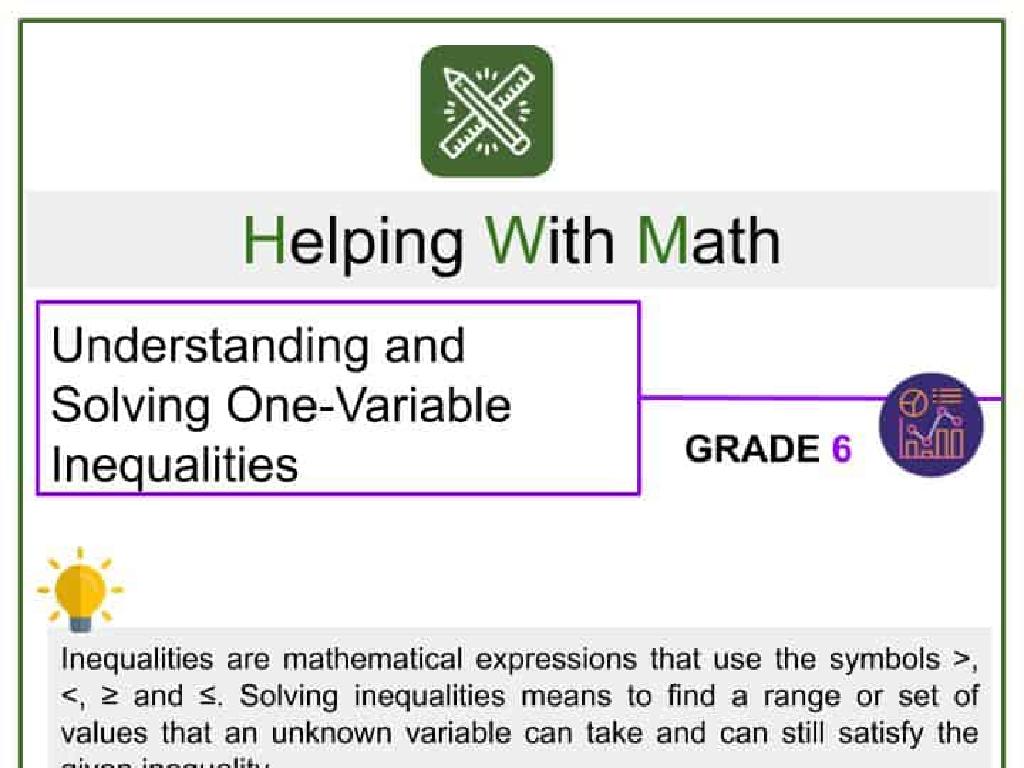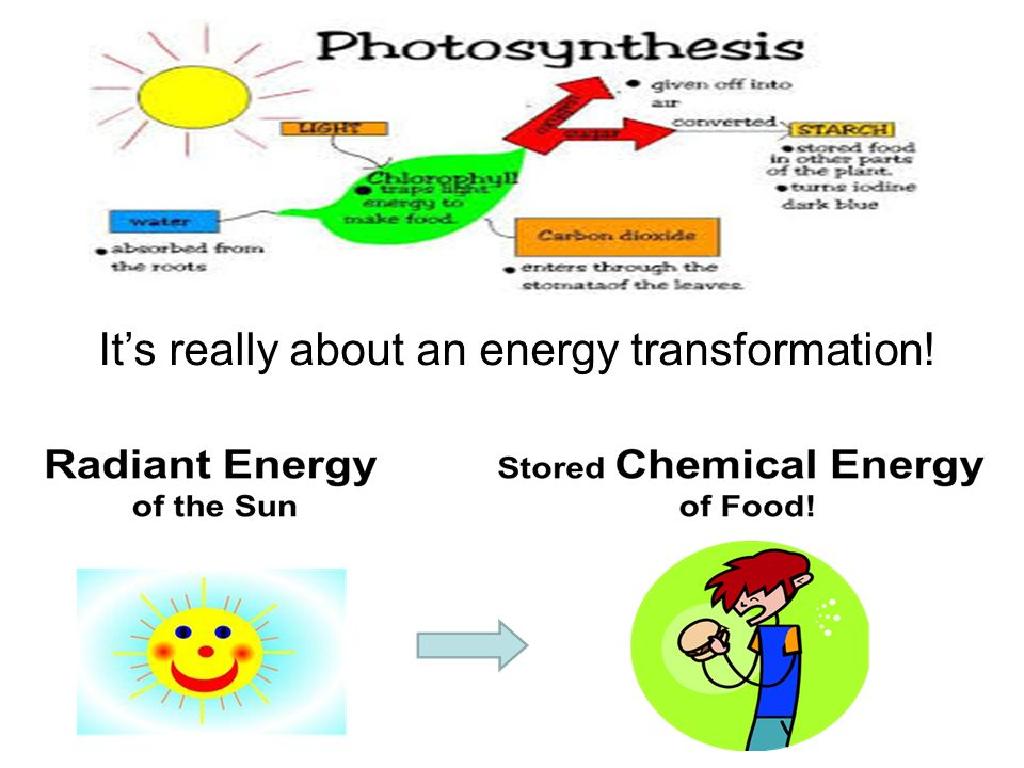Use Context To Identify The Meaning Of A Word
Subject: Language arts
Grade: Eighth grade
Topic: Context Clues
Please LOG IN to download the presentation. Access is available to registered users only.
View More Content
Welcome to Context Clues!
– Understanding context in text
– Context helps decipher word meanings without a dictionary.
– Importance of context clues
– Context clues enhance reading comprehension and vocabulary.
– Today’s goal: Context Detective
– Learn to find and use hints within sentences to define words.
– Strategies for context clues
– Use synonyms, antonyms, explanations, and examples in text.
|
This slide introduces the concept of using context to determine the meaning of unfamiliar words, an essential skill for reading comprehension. Emphasize the importance of context clues in understanding complex texts and expanding vocabulary. Today’s objective is to empower students to become ‘context clue detectives’ who can infer meaning through surrounding text. Teach various strategies such as looking for synonyms, antonyms, explanations, or examples that can help in defining new or difficult words. Encourage students to practice these skills with various texts to become proficient readers and independent learners.
Understanding Context Clues
– Definition of context clues
– Hints within the text to help understand new words
– The 5 types of context clues
– Definition, Synonym, Antonym, Example, Inference
– Locating context clues
– Clues may appear in the same or surrounding sentences
– Utilizing context clues effectively
– Practice deducing word meanings from context
|
Context clues are essential for students to develop their vocabulary and reading comprehension skills. By understanding that authors provide hints to define difficult words, students can become more independent readers. Introduce the five main types of context clues: definitions provided in the sentence, synonyms suggesting similar meanings, antonyms indicating opposite meanings, examples illustrating the word, and inferences that require readers to deduce the meaning. Emphasize that context clues can be found close to the unfamiliar word, either in the same sentence or nearby. Encourage students to practice identifying and using these clues in various texts to enhance their understanding of new vocabulary. Provide examples and exercises where students can apply these strategies to become more proficient readers.
Types of Context Clues
– Definition clues in sentences
– The sentence itself defines the new word.
– Synonym clues help identify meaning
– A similar word nearby hints at the meaning.
– Antonym clues offer contrast
– Opposite words used to highlight the meaning.
– Example clues for understanding
– Specific examples illustrate the word’s use.
– Inference clues require thinking
– Gather hints and deduce the word’s meaning.
|
This slide introduces students to the different types of context clues that authors use to help readers understand the meaning of unfamiliar words. Definition clues provide a direct explanation within the sentence. Synonym clues use a word with a similar meaning to give insight. Antonym clues use a contrasting word to define by opposition. Example clues provide concrete illustrations that shed light on the word’s meaning. Inference clues challenge students to think critically and piece together meaning from various hints in the text. Encourage students to look for these clues in their reading and practice identifying them with various exercises.
Identifying Context Clues
– Signal words for definitions
– Words like ‘means’, ‘refers to’, or ‘is defined as’ signal a definition.
– Contrast words for antonyms
– Words like ‘however’, ‘but’, or ‘yet’ often introduce an opposite meaning.
– Example indicators in sentences
– Phrases like ‘such as’ or ‘for instance’ often precede examples.
– Read around for contextual hints
– Understanding the full context is key; read the sentences around the word.
|
This slide aims to equip students with strategies to decipher the meaning of unfamiliar words using context clues. Emphasize the importance of signal words that often introduce a definition, which can directly explain the term. Highlight how contrast words can help identify antonyms, providing insight into the word’s meaning by understanding its opposite. Encourage students to look for example indicators that authors use to illustrate a point, which can be particularly helpful in understanding the term in context. Lastly, stress the importance of reading the text surrounding the unfamiliar word, as it often holds essential clues to the word’s meaning. Provide examples and practice sentences for students to apply these strategies.
Context Clues: Unveiling ‘Arboreal’
– Analyze sentence for clues
– ‘Arboreal creature’ example
– ‘such as a monkey’ hints arboreal relates to trees
– Context clues in action
– Look at words around ‘arboreal’ for hints
– Understanding ‘arboreal’
– ‘Arboreal’ means living in or often found in trees
|
This slide is designed to engage students in the practical application of context clues to determine the meaning of unfamiliar words. By examining the example sentence, students will see how surrounding words or phrases provide hints about the meaning of ‘arboreal.’ Encourage students to identify the phrase ‘such as a monkey’ as a key context clue, indicating that ‘arboreal’ relates to living in trees. Discuss how the action of leaping from tree to tree further supports this understanding. This exercise will help students become more adept at using context to infer meanings, a valuable skill for reading comprehension. In the next class, students can practice with additional sentences and share their findings.
Group Activity: Context Clue Challenge
– Break into small groups
– Distribute the worksheet
– Define bold words using context
– Use surrounding text to infer meaning
– Share and discuss findings
– Explain reasoning behind word meanings
|
This group activity is designed to enhance students’ skills in using context to determine the meaning of unfamiliar words. Divide the class into small groups to foster collaboration. Hand out the Context Clue Challenge worksheet, which contains sentences with bolded words that students need to define. Encourage students to look for synonyms, antonyms, explanations, or examples in the surrounding text to infer the meanings. After completing the task, each group will share their definitions and discuss the context clues that aided them. This will help students learn from each other and understand different strategies for using context clues. Possible activities for different groups could include varying the complexity of the sentences, focusing on different types of context clues, or having each group work on different paragraphs from the same story.
Class Discussion: Unveiling Word Meanings
– Review group activity answers
– Discuss types of context clues
– Definitions, synonyms, antonyms, examples, and inferences are types of clues.
– Share strategies for new words
– Use context clues, look for root words, and break down complex words.
– Plan for future word encounters
|
This slide is meant to facilitate a class discussion following a group activity on context clues. Start by reviewing the answers from the group activity to ensure understanding and correct any misconceptions. Then, lead a discussion on the different types of context clues, providing examples for each: definitions provided in the sentence, synonyms and antonyms indicating the word’s meaning, and general inferences that can be made from the text. Share strategies students can use when they encounter unfamiliar words, such as looking for root words and using the surrounding text to infer meaning. Encourage students to think about how they can apply these strategies in their future reading assignments. This discussion aims to reinforce the skills needed to independently decipher the meaning of new words and enhance vocabulary comprehension.
Homework Assignment: Mastering Context Clues
– Complete Context Clues worksheet
– Find 5 new words from reading
– Choose words unfamiliar to you
– Determine meanings using context
– Look for hints around each word
– Write sentences with new words
– Use each word in an original sentence
|
This homework assignment is designed to reinforce the lesson on using context clues to determine the meaning of new vocabulary. Students should complete the provided worksheet to practice the skill in a structured format. Additionally, they are tasked with identifying five new words from their personal reading material, which could be a book or an article. They must use context clues such as definitions, synonyms, antonyms, examples, or explanations within the text to infer the meanings of the words. Finally, students should construct their own sentences using the new words to demonstrate understanding. This exercise will help students to become more independent readers and improve their ability to comprehend complex texts. In the next class, be prepared to discuss some of the words students found challenging and how context clues helped them understand the meanings.
Conclusion: Mastering Context Clues
– Recap: Context clues are key
– Be a detective with new words
– Investigate words like a mystery to solve
– Practice with all types of texts
– The more you read, the better you get at spotting clues
– Context clues enhance comprehension
– Understanding context improves overall reading skills
|
As we wrap up, remember that context clues are essential tools for understanding new vocabulary and improving reading comprehension. Encourage students to approach unfamiliar words like detectives, looking for hints within the surrounding text. Emphasize the value of practice; the more they read, the more adept they’ll become at using context to decipher meanings. Remind them that this skill is not just for class but for life, enhancing their ability to understand various texts and communicate effectively. For homework, ask them to find examples of context clues in their favorite book or an article and bring them to the next class for discussion.

-satisfy-an-equation/basic_two_variable_equations.png)



